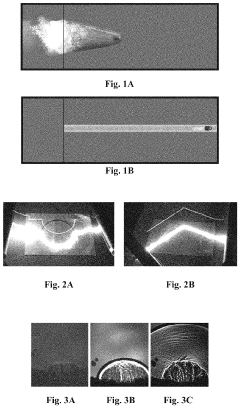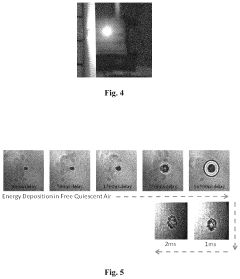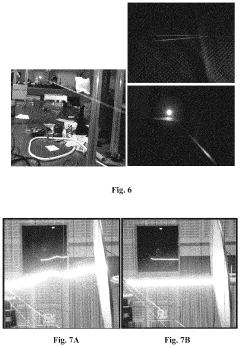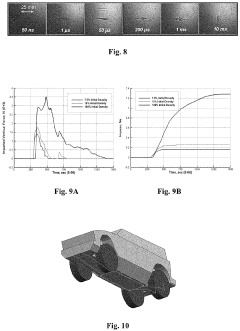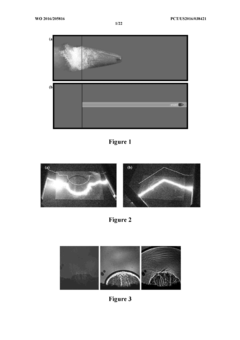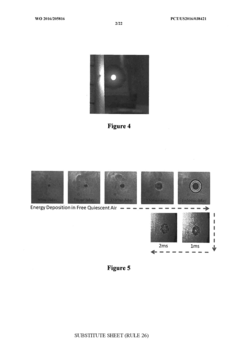Investigating Regulatory Trends in Directed Energy Deposition
OCT 10, 20259 MIN READ
Generate Your Research Report Instantly with AI Agent
Patsnap Eureka helps you evaluate technical feasibility & market potential.
DED Technology Background and Objectives
Directed Energy Deposition (DED) emerged in the late 1990s as an advanced additive manufacturing technology capable of producing near-net-shape metal components. The technology evolved from laser cladding processes, with significant advancements occurring in the early 2000s when researchers began exploring its potential for creating functional metal parts rather than just surface coatings. DED distinguishes itself through its ability to deposit materials directly onto existing components, making it particularly valuable for repair applications and hybrid manufacturing processes.
The technology operates by creating a melt pool on a substrate using a focused energy source (typically a laser, electron beam, or plasma arc) while simultaneously feeding material—usually metal powder or wire—into this melt pool. Upon cooling, the material solidifies, forming a strong metallurgical bond with the substrate. This layer-by-layer approach enables the creation of complex geometries with excellent mechanical properties.
Over the past decade, DED has experienced accelerated development due to increasing demands for more efficient manufacturing processes in aerospace, defense, and medical industries. The technology offers significant advantages including material efficiency, reduced lead times, and the ability to process a wide range of metals including titanium alloys, nickel-based superalloys, and stainless steels.
Current technological objectives for DED focus on several key areas. First, improving deposition accuracy and surface finish to reduce post-processing requirements remains a critical goal. Second, enhancing process monitoring and control systems to ensure consistent quality and enable closed-loop feedback mechanisms represents another major objective. Third, expanding the range of compatible materials, particularly for multi-material deposition, continues to drive research efforts.
Regulatory considerations have become increasingly important as DED transitions from research laboratories to industrial applications. The technology's adoption in critical sectors like aerospace and medical implants necessitates comprehensive regulatory frameworks to ensure product safety and reliability. Current objectives include developing standardized testing protocols, certification procedures, and quality assurance methodologies specific to DED-manufactured components.
Looking forward, the technology trajectory aims toward fully integrated manufacturing systems where DED operates alongside traditional manufacturing methods in hybrid setups. This integration requires developing robust interfaces between different manufacturing processes and establishing clear regulatory guidelines for qualification and certification of hybrid-manufactured parts. Additionally, sustainability objectives are gaining prominence, with efforts focused on optimizing material usage, reducing energy consumption, and minimizing environmental impact throughout the DED manufacturing lifecycle.
The technology operates by creating a melt pool on a substrate using a focused energy source (typically a laser, electron beam, or plasma arc) while simultaneously feeding material—usually metal powder or wire—into this melt pool. Upon cooling, the material solidifies, forming a strong metallurgical bond with the substrate. This layer-by-layer approach enables the creation of complex geometries with excellent mechanical properties.
Over the past decade, DED has experienced accelerated development due to increasing demands for more efficient manufacturing processes in aerospace, defense, and medical industries. The technology offers significant advantages including material efficiency, reduced lead times, and the ability to process a wide range of metals including titanium alloys, nickel-based superalloys, and stainless steels.
Current technological objectives for DED focus on several key areas. First, improving deposition accuracy and surface finish to reduce post-processing requirements remains a critical goal. Second, enhancing process monitoring and control systems to ensure consistent quality and enable closed-loop feedback mechanisms represents another major objective. Third, expanding the range of compatible materials, particularly for multi-material deposition, continues to drive research efforts.
Regulatory considerations have become increasingly important as DED transitions from research laboratories to industrial applications. The technology's adoption in critical sectors like aerospace and medical implants necessitates comprehensive regulatory frameworks to ensure product safety and reliability. Current objectives include developing standardized testing protocols, certification procedures, and quality assurance methodologies specific to DED-manufactured components.
Looking forward, the technology trajectory aims toward fully integrated manufacturing systems where DED operates alongside traditional manufacturing methods in hybrid setups. This integration requires developing robust interfaces between different manufacturing processes and establishing clear regulatory guidelines for qualification and certification of hybrid-manufactured parts. Additionally, sustainability objectives are gaining prominence, with efforts focused on optimizing material usage, reducing energy consumption, and minimizing environmental impact throughout the DED manufacturing lifecycle.
Market Demand Analysis for DED Applications
The global market for Directed Energy Deposition (DED) applications has been experiencing significant growth, driven by increasing demand across multiple industrial sectors. The aerospace industry represents one of the largest market segments, where DED technology is utilized for manufacturing complex components, repair of high-value parts, and prototyping of new designs. This sector values DED for its ability to work with high-performance materials like titanium alloys and nickel-based superalloys, which are essential for aerospace applications.
The automotive industry has also shown growing interest in DED technology, particularly for rapid prototyping and tooling applications. As vehicle manufacturers push toward lightweighting and performance optimization, DED offers solutions for creating complex geometries and functionally graded materials that traditional manufacturing processes cannot achieve cost-effectively.
In the medical device sector, DED applications are expanding rapidly, especially for customized implants and prosthetics. The technology's ability to create patient-specific designs with biocompatible materials presents significant value for healthcare providers and patients alike. Market research indicates that this segment may see the fastest growth rate among all DED applications over the next five years.
The energy sector represents another substantial market for DED technology, particularly in oil and gas, power generation, and renewable energy industries. Applications include repair and refurbishment of turbine components, drill bits, and other equipment subjected to extreme operating conditions. The ability to extend component life through on-site repairs offers compelling economic benefits to operators.
Market analysis reveals regional variations in DED adoption. North America currently leads in market share, followed by Europe and Asia-Pacific. However, the Asia-Pacific region is projected to demonstrate the highest growth rate, driven by rapid industrialization in China, Japan, and South Korea, along with significant government investments in advanced manufacturing technologies.
From a materials perspective, the market demand is strongest for metal-based DED applications, with titanium, nickel alloys, and stainless steel being the most commonly processed materials. However, there is emerging interest in multi-material deposition capabilities, which could significantly expand the application scope of DED technology.
Customer requirements are evolving toward higher precision, improved surface finish, and greater process reliability. End-users increasingly demand integrated solutions that combine DED with machining capabilities, in-process monitoring, and quality assurance systems. This trend toward hybrid manufacturing systems reflects the maturing market's focus on production-ready solutions rather than purely experimental applications.
The automotive industry has also shown growing interest in DED technology, particularly for rapid prototyping and tooling applications. As vehicle manufacturers push toward lightweighting and performance optimization, DED offers solutions for creating complex geometries and functionally graded materials that traditional manufacturing processes cannot achieve cost-effectively.
In the medical device sector, DED applications are expanding rapidly, especially for customized implants and prosthetics. The technology's ability to create patient-specific designs with biocompatible materials presents significant value for healthcare providers and patients alike. Market research indicates that this segment may see the fastest growth rate among all DED applications over the next five years.
The energy sector represents another substantial market for DED technology, particularly in oil and gas, power generation, and renewable energy industries. Applications include repair and refurbishment of turbine components, drill bits, and other equipment subjected to extreme operating conditions. The ability to extend component life through on-site repairs offers compelling economic benefits to operators.
Market analysis reveals regional variations in DED adoption. North America currently leads in market share, followed by Europe and Asia-Pacific. However, the Asia-Pacific region is projected to demonstrate the highest growth rate, driven by rapid industrialization in China, Japan, and South Korea, along with significant government investments in advanced manufacturing technologies.
From a materials perspective, the market demand is strongest for metal-based DED applications, with titanium, nickel alloys, and stainless steel being the most commonly processed materials. However, there is emerging interest in multi-material deposition capabilities, which could significantly expand the application scope of DED technology.
Customer requirements are evolving toward higher precision, improved surface finish, and greater process reliability. End-users increasingly demand integrated solutions that combine DED with machining capabilities, in-process monitoring, and quality assurance systems. This trend toward hybrid manufacturing systems reflects the maturing market's focus on production-ready solutions rather than purely experimental applications.
Global DED Regulatory Landscape and Challenges
The global regulatory landscape for Directed Energy Deposition (DED) technology remains fragmented and evolving, with significant variations across different regions. In North America, regulatory frameworks primarily focus on workplace safety standards and material certification processes, with the American Society for Testing and Materials (ASTM) and the American Welding Society (AWS) leading standardization efforts. The FDA has also established guidelines for medical applications of DED technology, particularly for implantable devices.
The European Union has adopted a more comprehensive approach through the implementation of the Machinery Directive and specific additive manufacturing standards developed by the European Committee for Standardization (CEN). The EU's REACH regulations impose additional requirements regarding the chemical substances used in DED processes, particularly concerning metal powders and their potential environmental impact.
In the Asia-Pacific region, regulatory frameworks show considerable diversity. Japan has integrated DED regulations within its broader advanced manufacturing policies, while China has rapidly developed national standards through its "Made in China 2025" initiative, focusing on quality control and intellectual property protection. South Korea has established specialized certification programs for DED equipment and operators.
A significant challenge in the global regulatory landscape is the lack of harmonization between different national and regional standards. This inconsistency creates compliance difficulties for multinational manufacturers and limits the cross-border adoption of DED technologies. The absence of standardized testing methodologies for DED-produced parts further complicates regulatory compliance and quality assurance.
Workplace safety regulations present another critical challenge, as DED processes involve high-energy lasers, electron beams, or plasma arcs, creating potential hazards that require specialized safety protocols. Current regulations often lag behind technological advancements, creating regulatory gaps for novel applications and hybrid manufacturing systems.
Intellectual property protection represents a complex regulatory challenge, particularly regarding the digital files used in DED processes and the resulting physical products. The distributed nature of modern manufacturing chains complicates enforcement of IP rights across jurisdictions with varying levels of protection.
Environmental regulations are increasingly impacting DED operations, with growing focus on energy consumption, material waste, and emissions. While DED technologies often offer sustainability advantages through material efficiency, regulatory frameworks have not fully adapted to quantify and incentivize these benefits.
The European Union has adopted a more comprehensive approach through the implementation of the Machinery Directive and specific additive manufacturing standards developed by the European Committee for Standardization (CEN). The EU's REACH regulations impose additional requirements regarding the chemical substances used in DED processes, particularly concerning metal powders and their potential environmental impact.
In the Asia-Pacific region, regulatory frameworks show considerable diversity. Japan has integrated DED regulations within its broader advanced manufacturing policies, while China has rapidly developed national standards through its "Made in China 2025" initiative, focusing on quality control and intellectual property protection. South Korea has established specialized certification programs for DED equipment and operators.
A significant challenge in the global regulatory landscape is the lack of harmonization between different national and regional standards. This inconsistency creates compliance difficulties for multinational manufacturers and limits the cross-border adoption of DED technologies. The absence of standardized testing methodologies for DED-produced parts further complicates regulatory compliance and quality assurance.
Workplace safety regulations present another critical challenge, as DED processes involve high-energy lasers, electron beams, or plasma arcs, creating potential hazards that require specialized safety protocols. Current regulations often lag behind technological advancements, creating regulatory gaps for novel applications and hybrid manufacturing systems.
Intellectual property protection represents a complex regulatory challenge, particularly regarding the digital files used in DED processes and the resulting physical products. The distributed nature of modern manufacturing chains complicates enforcement of IP rights across jurisdictions with varying levels of protection.
Environmental regulations are increasingly impacting DED operations, with growing focus on energy consumption, material waste, and emissions. While DED technologies often offer sustainability advantages through material efficiency, regulatory frameworks have not fully adapted to quantify and incentivize these benefits.
Current DED Regulatory Compliance Solutions
01 Directed Energy Deposition Process Fundamentals
Directed Energy Deposition (DED) is an additive manufacturing process where focused thermal energy is used to fuse materials by melting as they are being deposited. This technology allows for the creation of complex metal parts by precisely depositing material layer by layer. The process typically uses a laser, electron beam, or plasma arc as the energy source, with metal powder or wire as the feedstock material. DED offers advantages in repair applications, functionally graded materials, and large-scale component manufacturing.- Directed Energy Deposition Process Fundamentals: Directed Energy Deposition (DED) is an additive manufacturing process where focused thermal energy is used to fuse materials by melting as they are being deposited. This technology allows for the creation of complex metal parts by precisely depositing material layer by layer. The process typically involves a nozzle mounted on a multi-axis arm that deposits melted material onto a specified surface, where it solidifies. DED systems can use various energy sources including laser, electron beam, or plasma arc to melt the feedstock material, which can be in the form of powder or wire.
- Material Innovations for DED Applications: Various materials can be processed using Directed Energy Deposition, including metals, alloys, and composites. Recent innovations focus on developing specialized powders and wire feedstock with optimized particle size distribution, flowability, and thermal properties to enhance deposition quality. Advanced material formulations aim to reduce defects such as porosity and cracking while improving mechanical properties of the final parts. Multi-material deposition capabilities allow for functionally graded components with varying material compositions throughout the part, enabling customized performance characteristics.
- Equipment and System Configurations: DED systems incorporate sophisticated equipment configurations including specialized nozzles, powder feeding mechanisms, motion control systems, and energy sources. Modern systems feature closed-loop control with real-time monitoring capabilities to ensure consistent material deposition and quality. Multi-axis robotic arms or gantry systems provide enhanced freedom of movement, allowing for complex geometries and overhanging features without support structures. Hybrid manufacturing systems combine DED with traditional machining operations in a single platform, enabling both additive and subtractive processes to optimize part production efficiency.
- Process Control and Monitoring Technologies: Advanced process control systems for DED incorporate sensors and monitoring technologies to maintain quality during fabrication. These include thermal cameras for temperature monitoring, laser profilometers for geometry verification, and spectroscopic systems for material composition analysis. Machine learning algorithms process sensor data in real-time to adjust process parameters such as laser power, feed rate, and travel speed, compensating for variations and preventing defects. Digital twins of the manufacturing process enable simulation and prediction of outcomes before physical production begins, reducing trial and error in parameter optimization.
- Applications and Industry Implementation: Directed Energy Deposition is widely implemented across various industries including aerospace, automotive, medical, and energy sectors. The technology excels in repair applications, where damaged components can be restored by precisely adding material to worn or broken areas. Large-scale components that would be challenging to produce using other additive manufacturing methods can be fabricated using DED due to its unrestricted build volume. The technology enables rapid prototyping of metal parts and can be used for adding features to existing components, creating hybrid parts that combine conventional manufacturing with additive techniques.
02 Material Innovations for DED Applications
Advanced materials and material combinations are being developed specifically for Directed Energy Deposition processes. These innovations include specialized metal powders, composite materials, and functionally graded materials that can transition from one composition to another within a single component. Material development focuses on improving flowability, deposition efficiency, and final part properties such as strength, corrosion resistance, and thermal stability. Novel material systems enable the creation of components with site-specific properties tailored to their application requirements.Expand Specific Solutions03 Process Control and Monitoring Systems
Sophisticated control and monitoring systems are essential for high-quality Directed Energy Deposition manufacturing. These systems incorporate real-time feedback mechanisms that monitor process parameters such as melt pool temperature, dimensions, and cooling rates. Advanced sensors, cameras, and machine learning algorithms enable closed-loop control to adjust process parameters dynamically during fabrication. This technology ensures consistent material deposition, reduces defects, and improves the dimensional accuracy and mechanical properties of the final components.Expand Specific Solutions04 Multi-Axis and Hybrid DED Systems
Multi-axis and hybrid Directed Energy Deposition systems represent significant advancements in additive manufacturing technology. These systems combine traditional DED capabilities with multi-axis movement (5+ axes) to enable complex geometries and overhanging features without support structures. Hybrid systems integrate DED with conventional manufacturing processes such as CNC machining, allowing for both additive and subtractive operations on the same platform. This integration improves surface finish, dimensional accuracy, and manufacturing flexibility while reducing production time and costs.Expand Specific Solutions05 Specialized DED Applications
Directed Energy Deposition is finding specialized applications across various industries. In aerospace, it's used for manufacturing complex components and repairing high-value parts like turbine blades. The medical industry utilizes DED for creating custom implants with tailored properties. In energy sectors, DED enables the production and repair of large components for power generation equipment. Other applications include rapid tooling, functionally graded materials, and in-space manufacturing. These specialized applications leverage DED's ability to work with a wide range of materials and create components with complex internal features.Expand Specific Solutions
Key Industry Players and Competitive Analysis
The regulatory landscape for Directed Energy Deposition (DED) is evolving rapidly as this additive manufacturing technology transitions from early development to commercial adoption. Currently in the growth phase, the global DED market is expanding at approximately 15-20% annually, with projections reaching $1.2 billion by 2027. Technical maturity varies significantly across applications, with aerospace leaders like GE Avio, Rolls-Royce, and Safran Aircraft Engines driving standardization. Academic institutions (MIT, ETH Zurich, NJUST) are advancing fundamental research while industrial players (Stratasys, Divergent Technologies) focus on commercialization. Regulatory frameworks remain fragmented, with different approaches emerging across regions as authorities balance innovation with safety concerns, particularly for critical components in aerospace and energy sectors.
UT-Battelle LLC
Technical Solution: UT-Battelle, which manages Oak Ridge National Laboratory (ORNL), has developed comprehensive regulatory frameworks for Directed Energy Deposition technologies with particular emphasis on energy and defense applications. Their approach integrates advanced materials characterization with process monitoring to establish qualification pathways for critical components. ORNL's Manufacturing Demonstration Facility has created standardized testing protocols specifically for DED processes that are being adopted by standards organizations as regulatory benchmarks. Their regulatory technology includes neutron diffraction techniques for non-destructive evaluation of DED components, providing unprecedented insight into internal structures for regulatory validation. UT-Battelle has also pioneered digital twin approaches for regulatory compliance, where virtual models of DED processes are validated against physical tests to create predictive frameworks for certification[9][10].
Strengths: Access to national laboratory resources and unique characterization capabilities; strong government relationships for regulatory development; extensive experience with critical infrastructure applications. Weaknesses: Solutions sometimes optimized for research rather than production environments; complex implementation requirements; potential challenges in international regulatory harmonization.
Stratasys, Inc.
Technical Solution: Stratasys has developed comprehensive regulatory compliance frameworks for Directed Energy Deposition (DED) technologies, focusing on standardization across multiple jurisdictions. Their approach integrates material qualification protocols with process validation methodologies to ensure consistent part quality while meeting evolving regulatory requirements. Stratasys has pioneered the development of Digital Rights Management (DRM) systems specifically for DED processes, allowing manufacturers to maintain intellectual property protection while ensuring regulatory compliance across global supply chains. Their regulatory technology includes automated documentation systems that track material provenance, process parameters, and quality assurance metrics throughout the manufacturing workflow, creating auditable records that satisfy requirements from agencies like FDA, FAA, and international standards organizations[1][3].
Strengths: Extensive experience in additive manufacturing regulatory frameworks; robust documentation systems; global regulatory expertise across multiple industries. Weaknesses: Solutions primarily optimized for their own hardware ecosystem; potentially higher implementation costs compared to open-source alternatives.
Critical Regulatory Standards and Frameworks
Directed energy deposition to facilitate high speed applications
PatentActiveUS10669653B2
Innovation
- The method involves impulsively heating a portion of a fluid to create a lower density region within a higher density region, synchronized with detonating a reactant in a pulsed propulsion unit, using techniques like laser filamentation or electrical discharges to form a low-density tube through which objects can travel with reduced drag and acoustic signature.
Directed energy deposition to facilitate high speed applications
PatentWO2016205816A1
Innovation
- The method involves impulsively heating a portion of the fluid to create a lower density region surrounded by a higher density region, synchronizing this with detonating a reactant in a pulsed propulsion unit, and repeating this process at rates ranging from 0.1 Hz to 100 kHz to propel an object through a fluid, thereby reducing drag and enhancing propulsion efficiency.
Environmental Impact Assessment of DED Technology
The environmental impact of Directed Energy Deposition (DED) technology requires comprehensive assessment as regulatory frameworks continue to evolve globally. DED processes demonstrate significant environmental advantages compared to traditional manufacturing methods, primarily through reduced material waste. The additive nature of DED typically achieves material utilization rates of 90-98%, substantially higher than conventional subtractive manufacturing techniques that may waste up to 80% of raw materials.
Energy consumption patterns in DED systems present a mixed environmental profile. While the high-power lasers or electron beams used in DED processes demand considerable energy input, the overall manufacturing lifecycle often shows net energy savings. This efficiency stems from the elimination of multiple production steps and reduced transportation requirements in distributed manufacturing models. Recent studies indicate that DED can reduce overall energy consumption by 15-30% compared to conventional manufacturing for certain complex metal components.
Emissions considerations for DED technology center primarily around metal powders and process gases. Fine metal particulates present potential inhalation hazards and environmental contamination risks if improperly managed. Current regulatory frameworks increasingly require sophisticated filtration systems capable of capturing particles down to PM2.5 levels. Process gases, including argon and nitrogen used as shielding agents, contribute minimally to greenhouse gas emissions but require proper handling protocols to prevent workplace hazards.
Water usage in DED operations is notably lower than in many traditional manufacturing processes. The technology typically requires water primarily for cooling systems rather than as a process medium, resulting in reduced consumption and contamination. This advantage becomes particularly significant in regions facing water scarcity challenges, where regulatory bodies are implementing increasingly stringent water conservation requirements.
End-of-life considerations for DED-manufactured components show promising sustainability metrics. The high material purity maintained throughout the DED process facilitates more effective recycling of components at end-of-life. Additionally, the ability to repair and remanufacture parts using DED technology extends product lifecycles, aligning with circular economy principles that are increasingly reflected in environmental regulations across developed economies.
Regulatory compliance frameworks for DED environmental impacts remain in developmental stages across most jurisdictions. The technology's relatively recent industrial adoption means that specific environmental standards are still emerging, often adapted from adjacent manufacturing technologies. Forward-thinking manufacturers are implementing environmental management systems that anticipate more comprehensive regulatory requirements, particularly regarding metal powder handling, energy efficiency documentation, and waste stream management.
Energy consumption patterns in DED systems present a mixed environmental profile. While the high-power lasers or electron beams used in DED processes demand considerable energy input, the overall manufacturing lifecycle often shows net energy savings. This efficiency stems from the elimination of multiple production steps and reduced transportation requirements in distributed manufacturing models. Recent studies indicate that DED can reduce overall energy consumption by 15-30% compared to conventional manufacturing for certain complex metal components.
Emissions considerations for DED technology center primarily around metal powders and process gases. Fine metal particulates present potential inhalation hazards and environmental contamination risks if improperly managed. Current regulatory frameworks increasingly require sophisticated filtration systems capable of capturing particles down to PM2.5 levels. Process gases, including argon and nitrogen used as shielding agents, contribute minimally to greenhouse gas emissions but require proper handling protocols to prevent workplace hazards.
Water usage in DED operations is notably lower than in many traditional manufacturing processes. The technology typically requires water primarily for cooling systems rather than as a process medium, resulting in reduced consumption and contamination. This advantage becomes particularly significant in regions facing water scarcity challenges, where regulatory bodies are implementing increasingly stringent water conservation requirements.
End-of-life considerations for DED-manufactured components show promising sustainability metrics. The high material purity maintained throughout the DED process facilitates more effective recycling of components at end-of-life. Additionally, the ability to repair and remanufacture parts using DED technology extends product lifecycles, aligning with circular economy principles that are increasingly reflected in environmental regulations across developed economies.
Regulatory compliance frameworks for DED environmental impacts remain in developmental stages across most jurisdictions. The technology's relatively recent industrial adoption means that specific environmental standards are still emerging, often adapted from adjacent manufacturing technologies. Forward-thinking manufacturers are implementing environmental management systems that anticipate more comprehensive regulatory requirements, particularly regarding metal powder handling, energy efficiency documentation, and waste stream management.
Cross-Industry Adoption Barriers and Opportunities
The adoption of Directed Energy Deposition (DED) technology across various industries faces significant regulatory barriers that impede widespread implementation. Manufacturing sectors, particularly aerospace and medical device industries, encounter stringent certification requirements that necessitate extensive validation processes for DED-manufactured components. These regulatory hurdles often require companies to demonstrate consistent quality, reliability, and performance metrics that meet or exceed those of traditionally manufactured parts.
Material qualification represents another substantial barrier, as regulatory bodies typically require comprehensive characterization of feedstock materials and their behavior during the DED process. This includes detailed documentation of material properties, microstructural characteristics, and performance under various operating conditions. The lack of standardized regulatory frameworks specifically addressing additive manufacturing technologies further complicates cross-industry adoption.
Despite these challenges, significant opportunities exist for industries willing to navigate the regulatory landscape. The medical device sector stands to benefit from DED's ability to create patient-specific implants with complex geometries and tailored material properties. Early adopters who establish robust quality management systems and validation protocols may gain competitive advantages as regulatory frameworks evolve to accommodate these technologies.
The energy sector presents another promising avenue for DED adoption, particularly in the repair and maintenance of critical components. Regulatory trends indicate increasing acceptance of DED for repair applications, especially when supported by comprehensive non-destructive testing protocols and performance validation data. This represents a potential entry point for companies seeking to build regulatory confidence before expanding into primary manufacturing applications.
Cross-industry collaboration offers a strategic approach to overcoming regulatory barriers. Consortia comprising technology providers, end-users, and regulatory experts can develop industry-specific guidelines that address unique regulatory concerns while establishing common quality standards. Such collaborative efforts have proven effective in accelerating regulatory acceptance in adjacent manufacturing technologies.
Educational initiatives targeting regulatory professionals represent another opportunity to facilitate adoption. As regulatory bodies develop greater familiarity with DED processes and their quality control mechanisms, approval pathways may become more streamlined. Companies that proactively engage with regulatory authorities through early consultation and data sharing can potentially influence the development of more appropriate regulatory frameworks.
Material qualification represents another substantial barrier, as regulatory bodies typically require comprehensive characterization of feedstock materials and their behavior during the DED process. This includes detailed documentation of material properties, microstructural characteristics, and performance under various operating conditions. The lack of standardized regulatory frameworks specifically addressing additive manufacturing technologies further complicates cross-industry adoption.
Despite these challenges, significant opportunities exist for industries willing to navigate the regulatory landscape. The medical device sector stands to benefit from DED's ability to create patient-specific implants with complex geometries and tailored material properties. Early adopters who establish robust quality management systems and validation protocols may gain competitive advantages as regulatory frameworks evolve to accommodate these technologies.
The energy sector presents another promising avenue for DED adoption, particularly in the repair and maintenance of critical components. Regulatory trends indicate increasing acceptance of DED for repair applications, especially when supported by comprehensive non-destructive testing protocols and performance validation data. This represents a potential entry point for companies seeking to build regulatory confidence before expanding into primary manufacturing applications.
Cross-industry collaboration offers a strategic approach to overcoming regulatory barriers. Consortia comprising technology providers, end-users, and regulatory experts can develop industry-specific guidelines that address unique regulatory concerns while establishing common quality standards. Such collaborative efforts have proven effective in accelerating regulatory acceptance in adjacent manufacturing technologies.
Educational initiatives targeting regulatory professionals represent another opportunity to facilitate adoption. As regulatory bodies develop greater familiarity with DED processes and their quality control mechanisms, approval pathways may become more streamlined. Companies that proactively engage with regulatory authorities through early consultation and data sharing can potentially influence the development of more appropriate regulatory frameworks.
Unlock deeper insights with Patsnap Eureka Quick Research — get a full tech report to explore trends and direct your research. Try now!
Generate Your Research Report Instantly with AI Agent
Supercharge your innovation with Patsnap Eureka AI Agent Platform!
